How The Pro Beauty Industry Can Better Support Black Stylists
How The Pro Beauty Industry Can Better Support Black Creatives
As an industry, here’s how we can make an ongoing commitment to supporting, celebrating and amplifying Black stylists—by backing up our long-standing promises with an action plan that goes beyond this moment, but forever shifts the narrative. BTC is taking this time to listen and learn, so we spoke to a few artists on their experiences and ways we can better support Black students, educators and creatives. Read on!
1. How Beauty Schools Can Diversify Education
Let’s start with beauty school: If a student’s hands-on experience is limited to the clients being serviced in that school’s salon, it is impossible to receive a diversified education. We need to better understand how we can expand foundational education skills to support all stylists and clients, and every hair type. Let’s break it down.
Client-Based Education Limits Learning Opportunities
“We were taught specific [techniques] because those were the clients that were coming inside of the school to be serviced,” shares Celebrity Stylist, MIZANI Artist and Salon Owner, Jamal Edmonds (@lamajbackwards). “I was very experienced with relaxers and haircutting, but nothing advanced. I realized very quickly that I wanted to be able to offer other services and diversify my client base and staff,” shares Jamal.
Students who have recently graduated may have to immediately seek out advanced—and sometimes very costly—courses to learn more. “I went to [different schools] and learned other, more advanced techniques,” adds Jamal. “In the beginning, I felt pigeon-holed because I just didn’t have the experience that I felt like I needed to really push my career forward.”
Even if your school has a diverse clientele, make sure every student gets their hands on all types of hair, shares MIZANI Global Artistic Director, Celebrity and Editorial Stylist, Tippi Shorter (@tippishorter). In Tippi’s beauty school experience, she shared that she was always the student given Black clients. By doing this, it limits the learning experience for every student who should learn how to work with naturally straight, curly, wavy and highly-textured hair types.

What Happens When Curriculums Aren’t Inclusive
“[School] educators aren’t being educated and as a result, they aren’t setting up the stylists up for success,” shares Tippi. “Natural styling is being written into curriculums for [some] private schooling, but not in general schools.
What is it that we need to offer for our Black stylists? Nothing different, suggests Tippi. “Whatever education is happening on straight hair, that very same education needs to happen on hair that is curly,” shares Tippi. “When you’re doing color classes, the color doesn’t need to always be done by a white stylist on a white model. It’s just about seeing yourself more. The education isn’t different. I can apply a color technique to whatever medium I am working on.”
“The curriculum needs to change and something needs to be done while you’re building the foundation,” adds Jamal. “Beauty schools need to teach texture so stylists understand how it grows, what it needs, what works and what doesn’t work.”
How can we begin to fix this? By providing educators with ongoing education and bringing in color, cutting and natural styling experts. “Hair needs to be viewed as just hair, no matter who you are doing it on. You need to understand the fabric of hair, not the skin color,” shares Jamal. “That is a huge part of why it’s so segregated.”
2. Diversify Salon Education
“[Salons], add natural hair/texture education to your repertoire,” shares amika Global Artistic Director, Editorial Stylist and Platform Artist, Naeemah LaFond (@naeemahlafond), in a recent Instagram post. “As a salon owner, make curl care and natural texture education mandatory so that your services can be available to anyone who walks into your salon. Seek those educators who specialize in this category to come into your salons to teach.”
3. Hire Based On Talent
Go out of your comfort zone and hire based on talent, suggests Tippi. “You do need to see color and see when there’s not enough color in your space. You need to be purposeful that there is. You can’t speak to everybody if there’s not multiple voices in the room.”
“Hire us as hair stylists on your creative teams,” adds Naeemah. “Don’t just put us on your mood boards—put us on the call sheet.” Here are some ESSENTIAL points to understand:
- Bring in Black artists as creative leads, not as ghost assistants.
- Hire Black artists for EVERYTHING, not just texture. They can do it all.
- Not all Black stylists work on textured hair and not all textured hair is Black.
- Don’t only hire Black stylists when you have Black models.
- Go out of your comfort zone and hire based on talent.
- Normalize Black creatives in the pro beauty industry and the editorial world.

There needs to be more Black artists, industry leaders and voices at the table. “Black hair stylists also have specialties and are multilayered,” shares Naeemah. “Recognize that we are also mega influencers, celebrity stylists, film/TV hairstylists, theater hairstylists, wig specialists, haircutting specialists, hair color specialists, not just experts on Black hair. Allow us to lend our voices to all conversations whether it be on your panels, educational platforms, or as contributors to your publications.”
5. Beauty Is Not Just Rainbow Colors, Balayage & Beach Waves
“[Beauty] should be inclusive, all skin types and hair textures [and] all different types of styling techniques,” shares Jamal. Brands, publications and social channels must diversify their feeds. “When you [don’t] do that, you leave out this huge group of people, wondering is this not the space for me? Why is it not the space for them? We do beautiful work with depth, dimension and emotion and it should be showcased just like anybody else’s.”
Read Naeemah’s Guide To How Brands + Industry Decision Makers Can Support Black Stylists Below!







